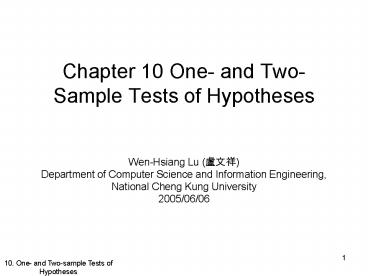Chapter 10 One and TwoSample Tests of Hypotheses - PowerPoint PPT Presentation
1 / 21
Title:
Chapter 10 One and TwoSample Tests of Hypotheses
Description:
Department of Computer Science and Information Engineering, National Cheng ... claims that 60% of all private residences being built today are 3-bedroom homes. ... – PowerPoint PPT presentation
Number of Views:26
Avg rating:3.0/5.0
Title: Chapter 10 One and TwoSample Tests of Hypotheses
1
Chapter 10 One- and Two-Sample Tests of
Hypotheses
- Wen-Hsiang Lu (???)
- Department of Computer Science and Information
Engineering, - National Cheng Kung University
- 2005/06/06
2
Statistical Hypotheses
- Decision based on experimental evidence whether
- Coffee drinking increases the risk of cancer in
humans. - A persons blood type or eye color are
independent variables. - Definition 10.1 A statistical hypothesis is an
assertion or conjecture concerning one or more
populations.
3
Role of Probability in Hypothesis Testing
- Awareness of the probability of a wrong
conclusion. - The acceptance of a hypothesis merely implies
that the data do not give sufficient evidence to
refute it. - Rejection means that there is a small probability
of obtaining the sample information observed when
the hypothesis is true. - E.g., for the conjecture of the fraction
defective p 0.10, a sample of 100 revealing 20
defective items is certainly evidence of
rejection. (probability 0.002)
4
Supporting a Contention
- Contention (??) coffee drinking increases the
risk of cancer - ?Hypothesis there is no increase in cancer risk
produced by drinking coffee - Contention one kind of gauge (????) is more
accurate than another - ?Hypothesis there is no difference in the
accuracy of the two kinds of gauges
5
Null and Alternative Hypotheses
- Structure of hypothesis
- Null hypothesis, H0 any hypothesis we wish to
test - Alternative hypothesis, H1 the opposite
hypothesis to reject H0 - Example
- H0 is the null hypothesis p 0.5 for a binomial
population, - H1 would be one of the following p gt 0.5, p lt
0.5, or p ? 0.5
6
Testing a Statistical Hypothesis
- Definition 10.2 Rejection of the null hypothesis
when it is true is called a type I error (level
of significance). - Definition 10.3 Acceptance of the null
hypothesis when it is false is called a type II
error.
7
Testing a Statistical Hypothesis
- Critical value the last number passing from the
acceptance region into the critical region. - H0 p 1/4 H1 p gt 1/4 (p 1/4, n 20,
binomial)
(Unlikely to commit a type I error)
8
Testing a Statistical Hypothesis
- The probability of committing both types of error
can be reduced by increasing sample size - Example H0 p 1/4 H1 p gt ¼ (n 100,
critical value 36) sol use the normal-curve
approximation with n gt 30.
9
Hypothesis Testing with a Continuous Random
Variable
- Consider the null hypothesis that the average
weight of male students in a certain college is
68 kilograms against the alternative hypothesis
that it is unequal to 68. - H0 ? 68 H1 ? ? 68
10
Hypothesis Testing with a Continuous Random
Variable
11
Hypothesis Testing with a Continuous Random
Variable
12
Hypothesis Testing with a Continuous Random
Variable
13
One- and Two-Tailed Tests
14
One- and Two-Tailed Tests
15
One- and Two-Tailed Tests
16
The Use of P-Values for Decision Making
17
The Use of P-Values for Decision Making
18
Single Sample Tests Concerning a Single Mean
(Variance Known)
19
Single Sample Tests Concerning a Single Mean
(Variance Known)
P P(Z gt 2.02) 0.0217
20
Single Sample Tests Concerning a Single Mean
(Variance Known)
P P(Z gt 2.83) 2 P(Z lt -2.83)
0.0046
21
Single Sample Tests on a Single Mean (Variance
Unknown)































